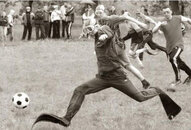The bicycle kick can make you go like heck with the right fins. My wife, using Aeris Velocity fins (vented, not split) went like a bat out of hell on the surface when skin-diving. That works all fine and good with an infinite supply of air.
The inescapable problem with using the bicycle kick when scuba diving is that it takes you out of profile and creates a lot of resistance to forward movement. That means more work, more air and less dive. (BTW, her kick is progressing well.)
Developing a strong predictable flutter kick requires some practice. Most divers can only get so much bottom time and that can make it hard. Try skin-diving in open water or doing laps in the pool. It was during some pool time a few years ago that I was able to really solidify my flutter kick from a form, coordination and endurance standpoint. Now when diving it seems like a lot of my kicks are just gentle ankle actions. If I'm in current or need to pour on the steam I can go into a full leg flutter and do well.
All of that is evolving into a modified flutter, sort of a frog kick etc. It all depends on the situation. If you can control yourself in the water without disturbing the bottom and are not the one ripping through your air supply call it good, have fun and evolve as a diver.
Pete
The inescapable problem with using the bicycle kick when scuba diving is that it takes you out of profile and creates a lot of resistance to forward movement. That means more work, more air and less dive. (BTW, her kick is progressing well.)
Developing a strong predictable flutter kick requires some practice. Most divers can only get so much bottom time and that can make it hard. Try skin-diving in open water or doing laps in the pool. It was during some pool time a few years ago that I was able to really solidify my flutter kick from a form, coordination and endurance standpoint. Now when diving it seems like a lot of my kicks are just gentle ankle actions. If I'm in current or need to pour on the steam I can go into a full leg flutter and do well.
All of that is evolving into a modified flutter, sort of a frog kick etc. It all depends on the situation. If you can control yourself in the water without disturbing the bottom and are not the one ripping through your air supply call it good, have fun and evolve as a diver.
Pete





